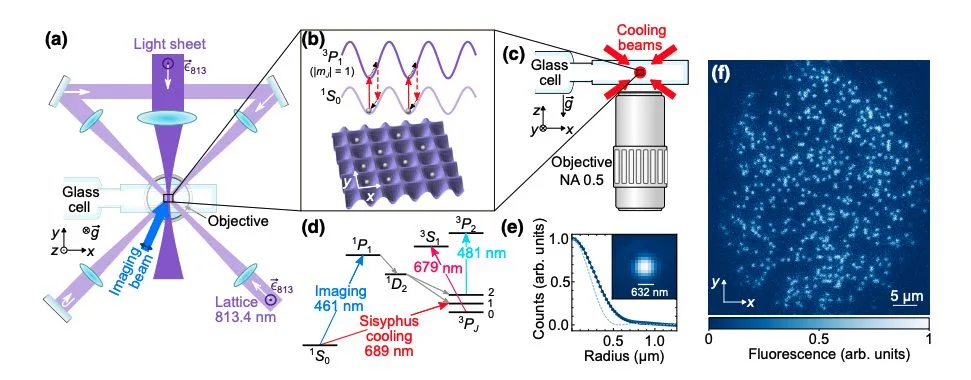A team of researchers from the Barcelona Institute of Science and Technology and the Catalan Institution for Research and Advanced Studies have developed a Strontium Quantum Gas Microscope. This device allows scientists to observe and manipulate quantum gases at the single-atom level using a bosonic quantum gas of Strontium-84. The microscope provides a new platform for studying many-body systems at the single-atom level, quantum magnetism, transport properties in many-body systems, and quantum thermalization. It also has potential applications in the development of quantum computers. The team’s findings have been published in the journal PRX Quantum.
What is a Strontium Quantum Gas Microscope?
A Strontium Quantum Gas Microscope is a device that allows scientists to observe and manipulate quantum gases at the single-atom level. This technology has been developed by a team of researchers from the Barcelona Institute of Science and Technology and the Catalan Institution for Research and Advanced Studies. The team, led by Sandra Buob, Jonatan Höschele, Vasiliy Makhalov, Antonio Rubio Abadal, and Leticia Tarruell, has published their findings in the journal PRX Quantum.
The microscope uses a bosonic quantum gas of Strontium-84, an alkaline-earth element, confined in a Hubbard-regime optical lattice. The quantum gas is confined by a two-dimensional in-plane lattice and a light-sheet potential, which operate at the strontium clock-magic wavelength of 813.4 nm. The team has demonstrated site-resolved imaging of the quantum gas, achieving imaging fidelities above 94%.
How Does the Strontium Quantum Gas Microscope Work?
The Strontium Quantum Gas Microscope operates by using fluorescence imaging with the broad 461nm transition, which provides high spatial resolution. Simultaneously, the team performed attractive Sisyphus cooling with the narrow 689nm intercombination line. The atomic occupation is reconstructed from the fluorescence images.
The microscope also allows for the realization of a Strontium-84 superfluid in the Bose-Hubbard regime. The team observed its interference pattern upon expansion, a probe of phase coherence with single-atom resolution. This makes the Strontium Quantum Gas Microscope a new platform to study dissipative Hubbard models, quantum optics in atomic arrays, and SU N fermions at the microscopic level.
What are the Applications of the Strontium Quantum Gas Microscope?
The Strontium Quantum Gas Microscope opens up exciting opportunities for quantum simulation. It allows for the study of SU N symmetric systems, quantum magnetism, transport properties in many-body systems, and quantum thermalization, among other things. The microscope can also be used as a precise probe due to the narrow and ultra-narrow optical transitions of alkaline-earth elements.
The Strontium Quantum Gas Microscope is particularly useful for studying atomic species with two valence electrons, such as alkaline-earth and alkaline-earth-like atoms. These atoms have distinct electronic structures with singlet and triplet states, which can be used to store quantum information. The microscope can also be used to study spin-orbit coupling using the metastable clock state, dissipative Bose-Hubbard models, and SU N fermions.
What Makes the Strontium Quantum Gas Microscope Unique?
The Strontium Quantum Gas Microscope is unique because it extends quantum gas microscopy to alkaline-earth elements. Most microscope setups to date have been realized with alkali atoms, which have only one valence electron. The Strontium Quantum Gas Microscope, on the other hand, allows for the study of atomic species with two valence electrons.
The Strontium Quantum Gas Microscope also uses a bosonic quantum gas of Strontium-84, an interacting bosonic isotope. This is different from previous studies of hybrid systems, which have focused on the Strontium-88 isotope. The Strontium-84 isotope allows for the attainment of the interacting Hubbard regime and reaching quantum degeneracy through evaporative cooling.
What is the Future of the Strontium Quantum Gas Microscope?
The development of the Strontium Quantum Gas Microscope is a significant step forward in the field of quantum science and technology. It provides a new platform for the study of many-body systems at the single-atom level, which could lead to breakthroughs in our understanding of quantum physics.
The Strontium Quantum Gas Microscope also has potential applications in the development of quantum computers. By allowing for the precise control and detection of individual particles, the microscope could be used to manipulate quantum bits, or qubits, the basic units of information in a quantum computer.
In the future, the team plans to continue refining the Strontium Quantum Gas Microscope and exploring its potential applications. They believe that their work could pave the way for new discoveries in the field of quantum simulation and beyond.
Publication details: “A Strontium Quantum-Gas Microscope”
Publication Date: 2024-04-18
Authors: Sandra Buob, Jonatan Höschele, Vasiliy Makhalov, Antonio Rubio-Abadal, et al.
Source: PRX Quantum 5, 020316
DOI: https://doi.org/10.1103/PRXQuantum.5.020316

